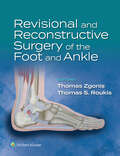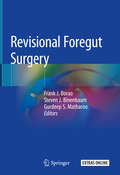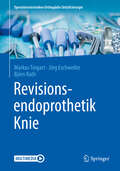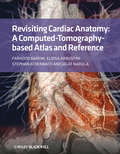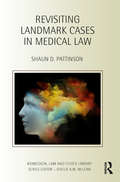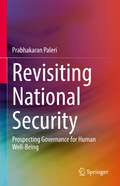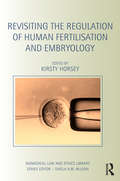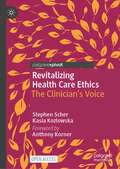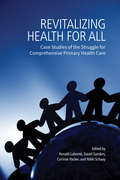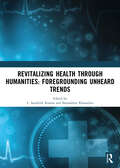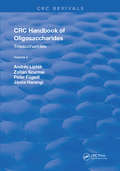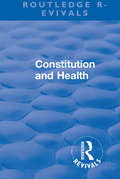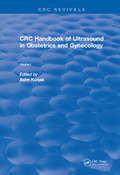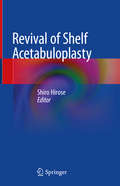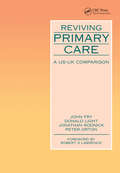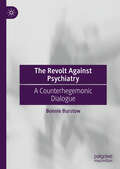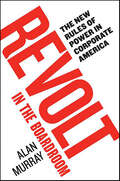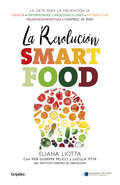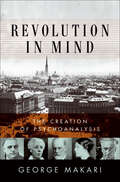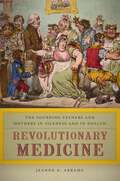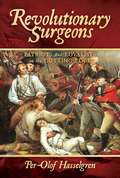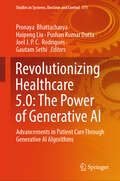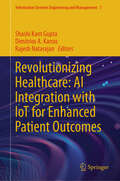- Table View
- List View
Revisional and Reconstructive Surgery of the Foot and Ankle
by Thomas Zgonis Thomas S. RoukisComprehensive and highly illustrated, Revisional and Reconstructive Surgery of the Foot and Ankle is a problem-based guide for both orthopaedic and podiatric foot and ankle surgeons who perform revision surgeries for complications resulting from foot and ankle procedures. Edited by Dr. Thomas Zgonis, author of the well-regarded Surgical Reconstruction of the Diabetic Foot and Ankle, along with co-editor Dr. Thomas S. Roukis, this up-to-date reference provides authoritative, easy-to-follow guidance from recognized experts in the field.
Revisional Foregut Surgery
by Frank J. Borao Steven J. Binenbaum Gurdeep S. MatharooThis book is divided into 3 parts, each containing chapters that cover commonly encountered clinical scenarios of reoperative surgery. These parts include revisional bariatric surgery, reoperation for complications of bariatric surgery, and revisional anti-reflux and gastric procedures. The information covered discusses existing literature and best-practices in patient care, with a focus on operative technique, pitfalls, and post-operative complications. The aim of this book is to provide the reader with information on how to successfully manage a patient requiring reoperation. Chapters also highlight the difference in patient outcomes when the procedures are completed in a minimally invasive approach rather than an open approach.Revisional Foregut Surgery serves as a valuable resource for medical students, surgical residents, fellows, and attending surgeons seeking advice and guidance on reoperative upper gastrointestinal surgery and their related complications.
Revisionsendoprothetik Knie (Operationstechniken Orthopädie Unfallchirurgie)
by Markus Tingart Jörg Eschweiler Björn RathDieses Buch gibt einen Überblick über die Hauptversagensgründe von Knieprothesen und bietet in prägnanten Texten und Grafiken einen Leitfaden zur Indikationsstellung und zur operativen Durchführung von Revisionseingriffen am Kniegelenk. Der Schwerpunkt liegt dabei auf der Praxis: Schritt für Schritt wird das How to do beschrieben. Darüber hinaus vermitteln die Autoren zahlreiche Tipps und Tricks, die für einen erfolgreichen Operationsverlauf essentiell sind. Neben den brillanten Grafiken und Fotos illustriert und erläutert ein 10-minütiges Video alle entscheidenden Schritte am Beispiel eines exemplarischen Revisionseingriffes. So ist die Umsetzung der Theorie in die Praxis auf kurzem Weg möglich.
Revisiting Barrett’s Esophagus
by Giuseppe GalloroThis book focuses on Barrett’s Esophagus (BE), a clinical condition that must be evaluated in all patients affected by chronic GERD, and with an important link to esophageal cancer. Divided into four sections (morphological background, epidemiology and natural history, diagnosis, and treatments), this handy volume provides the latest indications regarding endoscopic approaches (first level and advanced endoscopy), pathological studies (pathology and molecular biology), and state-of-the-art therapeutic options (medical, endoscopic, and surgical) for BE. As such, it offers a valuable reference guide for all professionals involved in the management of BE (gastroenterologists, endoscopists, pathologists and surgeons), offering them a comprehensive overview and deeper understanding of this seemingly superficial disease.
Revisiting Cardiac Anatomy
by Farhood SaremiThis new atlas represents a fresh fresh approach to cardiac anatomy, providing images of unparalleled quality, along with explanatory text, to show in vivo heart anatomy and explain the clinically relevant underlying anatomic concepts. In spite of amazing proliferation of information on the Internet and multiple websites filled with up-to-date information, there is no similarly detailed and systematic compilation of morphological imaging with CT. Organized for both systematic learning and to serve as a quick, yet detailed reference for specific clinical questions, this book is an invaluable resource for medical students and residents, cardiologists, and especially surgeons, interventionalists and electrophysiologists, who depend on ever more detailed imaging support in order to successfully perform increasingly complex coronary and noncoronary structural interventions and other procedures.
Revisiting Landmark Cases in Medical Law (Biomedical Law and Ethics Library)
by Shaun D. PattinsonIs it lawful for a doctor to give a patient life-shortening pain relief? Can treatment be lawfully provided to a child under 16 on the basis of her consent alone? Is it lawful to remove food and water provided by tube to a patient in a vegetative state? Is a woman’s refusal of a caesarean section recommended for the benefit of the fetus legally decisive? These questions were central to the four focal cases revisited in this book. This book revisits nine landmark cases. For each, a new leading judgment is attributed to an imagined judge, Athena, who operates within the constraints of the legal system of England and Wales. Her judgments accord with an innovative legal theory, referred to as ‘modified law as integrity’, and are linked as a line of precedent. The result is a re-spinning of extant judicial threads into a web of legal principles with a greater claim to coherence and defensibility than those in the original cases. The book will be of great interest to scholars and students of medical law, criminal law, bioethics, legal theory and moral philosophy.
Revisiting National Security: Prospecting Governance for Human Well-Being
by Prabhakaran PaleriThis book examines the evolving concept of national security and how human systems could be governed in an ever turbulent and dynamic world. It takes a revised look at the concept of national security, previously researched and identified by the author, based on the present context but with a futuristic appreciation of governance, primarily national but extended to global perspectives, in the modern and dynamically shifting world. The book emphasises the need for governments to maximise national security for the well-being of their people. The concept of national security is taken as the key subject of national governance which is extendable to global governance wherein national security is not only the physical or military security alone but also the overall well-being of the people of a nation. This book explores how national security can be achieved by balancing its various elements in different terrains where the game of governance is played in national as well as global perspective. It also presents additional findings and observations to show that the approach is transformative, redefining the key knowledge paradigms. This book is relevant for policy makers, students, researchers and academics who wish to explore and rethink their approach towards governing the human systems, whose well-being is the responsibility of governments.
Revisiting the Regulation of Human Fertilisation and Embryology (Biomedical Law and Ethics Library)
by Kirsty HorseyThe Human Fertilisation and Embryology Act 2008 was a major update to the UK’s laws on the use and regulation of reproductive technology and assisted reproduction. Since the enactment of the new law, the sector’s regulatory body, the Human Fertilisation and Embryology Authority (HFEA), has also consulted on various related topics including barriers to egg and sperm donation in the UK, multiple births/single embryo transfer and using IVF technology to prevent mitochondrial disease. This book critically considers recent developments in human fertilisation legislation, asking whether the 2008 Act has achieved its stated aim of being fit for purpose. Bringing together a range of international experts, the book evaluates the fresh risks and challenges emerging from both established and existing technologies and techniques in the field of human fertilisation and embryology, as well as offering valuable insights into the social and regulatory challenges that lie ahead. Key topics include problems with DIY assisted conception; the lack of reform in respect of the regulation of surrogacy arrangements; and mitochondrial DNA transfer. As a review of the status of assisted reproduction legislation, this book will be of great use and interest to students, researchers and practitioners in medical law, bioethics, medicine and child welfare.
Revitalizing Health Care Ethics: The Clinician’s Voice
by Stephen Scher Kasia KozlowskaThis open access book explores the origins and development of the clinician’s moral voice and how that voice is embedded in the informal ethical discourse of everyday health care. This moral voice, developed over the course of a lifetime—including through professional education and practice—enables clinicians to understand and address the ethical issues that arise in their everyday work with patients, families, and colleagues. The early chapters explain how health care students move from outsiders to insiders—members of the distinct moral and professional communities that define each particular field of health care. The book describes how students, trainees, and clinicians draw on and extend their own existing intellectual, emotional, and moral capacities, and how they use these capacities to address the daily challenges, ethical and otherwise, that arise in the clinic. This approach is designed both to empower clinicians and to inform bioethicists and others in their attempts to work more effectively within clinical settings. This book is available open access under a CC BY-NC-ND 4.0 license.
Revitalizing Health for All: Case Studies of the Struggle for Comprehensive Primary Health Care
by Corinne Packer David Sanders International Development Research Centr Nikki Schaay Ronald LabontéThe concept of Comprehensive Primary Health Care focuses on health system efforts to improve equity in health care access, community empowerment, participation of marginalized groups, and actions on the social determinants of health. Despite its existence since the late 1970s very few studies have been able to highlight the outcomes of this concept, until now. Revitalizing Health for All examines thirteen cases of efforts to implement CPHC reforms from around the globe including Australia, Brazil, Democratic Republic of Congo, Iran, South Africa, and more. The findings presented in this volume originate from an international action-research set of studies that utilized triads of senior and junior researchers and knowledge users from each country’s public health system. Primary health care reform is an important policy discourse both at the national level in these countries and in the global conversations, and this volume reveals the similarities among CPHC projects in diverse national contexts. These similarities provide a rich evidence base from which future CPHC reform initiatives can draw, regardless of their country.
Revitalizing Health Through Humanities: Proceedings of the International Conference on Health and Humanities: Exploring Uncharted Terrains in Literary Paradigms
by L. Santhosh Kumar Barnashree Khasnobis Sreedevi SanthoshHealth Humanities in contemporary times has enabled exploration of the unexplored chartered terrains in literary paradigms. Scholars in the field of Humanities and Sciences have been engaging with the praxis of applying concepts from both disciplines revising the approach towards Health Care and Humanities. Due to interdisciplinary and multidisciplinary methodologies of reading literary texts, they have been reinforcing a paradigm shift from the conventional understanding of narratives in Literature and Health Care. Traditional discursive boundaries between the disciplines of Health and Humanities are collapsing due to a comprehensive and nuanced interpretation of the shared ontological foundation between the two – Humanism. Terminologies like Displacement, Dislocation, and Disjunction unite Health and Humanities and they also make the unknown, known. Health Humanities explores the different multitudes of narration in the literary arena and it represents diverse voices of literature. It also showcases the importance of re-reading a text owing to its autotelic status. The authors who have contributed chapters for this book have meticulously selected diverse texts and contexts, embedded in the dynamism of Health Humanities. This book is an impetus for academicians from the field of Humanities and Sciences who desire to venture into new epistemes towards Health Humanities.
Revival: Volume II (CRC Press Revivals)
by Andras Liptak Zoltan Szurmai Janos Harangi Péter FügediChemical synthesis of oligosaccharides is important to organic chemistry because of the critical biological functions of carbohydrates. Unfortunately, no handbook has been published on the subject...until now. Volume 1: Disaccharides presents synthetic carbohydrate chemistry, lists the syntheses, and shows the route of each synthesis. Volume 2: Trisaccharides presents schematic figures and references. This series includes all oligosaccharides synthesized between 1960 and 1986. This allows oligosaccharides prepared in their free form to be presented, as well as those produced in protected form. The series contains data regarding glycosylation reaction, namely reaction conditions (solvent, promoter, temperature), the aglycon and the glycosyl donor used, and the structure and physical data of the isolated product. For disaccharides, the names of the reactants and the products are revealed, while with trisaccharides and higher oligomers, schematic figures provide a quick and easy way to access information concerning the entire process. These volumes will provide an important reference source for biochemists, biologists, and organic chemists.
Revival: Constitution And Health (1933) (Routledge Revivals)
by Raymond PearlThe material in this book is an expansion of a lecture given at the Army Medical Center, Washington, D.C., on May 15, 1933. I have thought it best to leave it in the somewhat informal discourse of the lecture platform. References to the literature, and other annotations, are numbered consecutively and placed together at the end of the book. It should be pointed out here at the start, as it is in the text, that the author is not a medical man, but merely a biologist greatly interested in human biology; aware of his deficiencies in knowledge and experience consequent upon not having an equally lively sense of his inalienable right as a biologist to study man, the most interesting of all animals.
Revival: CRC Handbook of Ultrasound in Obstetrics and Gynecology, Volume I (CRC Press Revivals)
by Asim KurjakThis practical, two-volume handbook is the first to illustrate the use of transvaginal color doppler in obstetrics and gynecology. It provides a critical look at state-of-the-art ultrasound techniques and equipment and serves as a comprehensive reference with numerous black/white and color ultrasonograms, tables and graphs. The volumes include extensive literature citations which assist the investigator in finding more in-depth references. This work focuses on the recent remarkable expansion in both diagnostic techniques and clinical applications. It reports findings based on an unusually large patient population over a long period of time. It presents the accuracy and limitations of various aspects of ultrasound. This important publication is especially helpful for clinicians and researchers.
Revival of Shelf Acetabuloplasty
by Shiro HiroseThis book provides an up-to-date overview of shelf acetabuloplasty, a traditional procedure for acetabular dysplasia.Originally, shelf acetabuloplasty was mainly intended for the treatment of developmental dysplasia of the hip (DDH) in children and adolescents. However, secondary osteoarthritis of the hip due to DDH is more common than primary osteoarthritis, and shelf acetabuloplasty was subsequently applied to such cases in adults. Recently, periacetabular pelvic osteotomies, such as the rotational acetabular osteotomy have established themselves and are broadly indicated as joint-preserving operations for secondary hip osteoarthritis. With the increased interest in pelvic osteotomies, the role of shelf acetabuloplasty as a reliable and safe procedure now needs to be redefined. Each chapter was prepared by an expert in his or her field. The authors highlight the essence of the indication, discuss advanced and cutting-edge techniques, and assess the outcomes of shelf acetabuloplasty. Taken together, they provide a valuable contribution to hip surgery.
Reviving Primary Care: A US-UK Comparison
by John Fry Donald W. Light Robert M. LawrenceThe quality of health care in the US depends on the patient's ability to pay and his or her insurance cover, at an annual cost of $3600 per head of population. In the UK, the quality of care costs less at an annual cost of $1000 per head of population, although care is sometimes delayed through a lack of resources. This book compares the two systems from the viewpoint of primary care, identifying some models of excellence from which both can benefit. It draws on the experience of the NHS reforms in the UK and the political imperative to control costs and improve the service in the US.
The Revolt Against Psychiatry: A Counterhegemonic Dialogue
by Bonnie BurstowA real eye-opener, this riveting anti/critical psychiatry book is comprised of original cutting-edge dialogues between Burstow (an antipsychiatry theorist and activist) and other leaders in the “revolt against psychiatry,” including radical practitioners, lawyers, reporters, activists, psychiatric survivors, academics, family members, and artists. People in dialogue with the author include Indigenous leader Roland Chrisjohn, psychiatrist Peter Breggin, survivor Lauren Tenney, and scholar China Mills. The single biggest focus/tension in the book is a psychiatry abolition position versus a critical psychiatry (or reformist) position. In the scope of this project, Burstow considers the ways racism, genocide, Indigeneity, sexism, media bias, madness, neurodiversity, and strategic activism are intertwined with critical and antipsychiatry.
Revolt in the Boardroom: The New Rules of Power in Corporate America
by Alan MurrayThroughout the 20th century, American corporations were governed by autocratic, almost unaccountable chief executives. Their word was law and the only check on their power was a board of directors composed of their friends and allies.Then, in a stunning reversal, a momentous series of firings deposed the heads of some of the world's best-known companies: AIG, Morgan Stanley, Boeing, Hewlett-Packard and Pfizer, just to name a few. Formerly unchallenged CEOs found themselves under fire, often from their own handpicked boards. The number of deposed executives is astonishing. In 2004, the leaders of 600 companies were asked to leave. That number more than doubled in 2005 and reached 1,400 companies in 2006.Flexing new muscles, directors are assuming new and unfamiliar responsibilities. In Revolt in the Boardroom, Alan Murray reveals the inner workings of the new seat of power. Using the access afforded to him by his influential Wall Street Journal column, Murray tells the story of three seminal board revolts—the now-famous Hewlett-Packard drama, the ousting of Boeing's Harry Stonecipher and the end of the reign one of the world's most autocratic executives, Hank Greenberg at AIG.Murray goes further to chart the history of the corporation, the rise of governance and the effects of the new power gained by outside institutions like hedge funds and interest groups. Through it all, Murray shows how the job of chief executive has rapidly and permanently changed. Leaders like A. G. Lafley and Jeff Immelt govern instead of rule, build alliances and support instead of dictating direction and pay careful attention to a broader range of stakeholders than ever before.Revolt in the Boardroom is the first look at the new world of corporate power and the last word on the transformational events of the last two years.
La revolución Smartfood
by Eliana Liotta Lucilla Titta Pier Giuseppe PelicciEl libro de la dieta para la prevención de cáncer, enfermedades cardiovasculares, metabólicas, neurodegenerativas y el control de peso. Descubre cómo mantenerte sano y en forma con los 30 alimentos que alargan la vida. Aunque estemos genéticamente predispuestos a determinadas enfermedades, una sana y correcta alimentación puede «corregir nuestro destino». Esta es la premisa de La revolución Smartfood, el primer libro de nutrición que propone una dieta certificada por los científicos del Instituto Europeo de Oncología y del Centro Cardiológico Monzino. También es la primera vez que una dieta se relaciona indisolublemente con la prevención del cáncer, del envejecimiento y de las patologías cardiovasculares, metabólicas y neurodegenerativas. Los protagonistas de esta revolución son 30 alimentos que contienen moléculas que influyen en la duración y la calidad de la vida, y que protegen el organismo y lo preservan de la obesidad, del envejecimiento y otras enfermedades crónicas. Además, La revolución Smartfood: - Propone un esquema correcto de alimentación para toda la familia. - Presenta recetas sabrosas para convertir la salud en un estilo de vida. - Muestra sugerencias y secretos para la conservación y la óptima cocción de los alimentos. - Desmitifica creencias erróneas.
Revolution in Mind: The Creation of Psychoanalysis
by George MakariA masterful history of one of the most important movements of our time, Revolution in Mind is a brilliant, engaging, and radically new work—the first ever to fully account for the making of psychoanalysis. In a sweeping narrative, George Makari demonstrates how a new way of thinking about inner life coalesced and won followers who spread this body of thought throughout the West. Along the way he introduces the reader to a fascinating array of characters, many of whom have been long ignored or forgotten.Amid great ferment, Sigmund Freud emerged as a creative, interdisciplinary thinker who devised a riveting new theory of the mind that attracted acolytes from the very fields the Viennese doctor had mined for his synthesis. These allies included Eugen Bleuler, Carl Jung, and Alfred Adler, all of whom eventually broke away and accused the Freudian community of being unscientific. Makari reveals how in the wake of these crises, innovators like Sándor Ferenczi, Wilhelm Reich, Melanie Klein, and others reformed psychoanalysis, which began to gain wide acceptance only to be banished from the continent and sent into exile due to the rise of fascism.Groundbreaking, insightful, and compulsively readable, Revolution in Mind goes beyond myth and polemic to give us the story of one of the most controversial intellectual endeavors of the twentieth century.
Revolutionary Medicine: The Founding Fathers and Mothers in Sickness and in Health
by Jeanne E AbramsAn engaging history of the role that George Washington, Thomas Jefferson, and Benjamin Franklin played in the origins of public health in America. Before the advent of modern antibiotics, one&’s life could be abruptly shattered by contagion and death, and debility from infectious diseases and epidemics was commonplace for early Americans, regardless of social status. Concerns over health affected the Founding Fathers and their families as it did slaves, merchants, immigrants, and everyone else in North America. As both victims of illness and national leaders, the Founders occupied a unique position regarding the development of public health in America. Historian Jeanne E. Abrams&’s Revolutionary Medicine refocuses the study of the lives of George and Martha Washington, Benjamin Franklin, Thomas Jefferson, John and Abigail Adams, and James and Dolley Madison away from politics to the perspective of sickness, health, and medicine. For the Founders, republican ideals fostered a reciprocal connection between individual health and the &“health&” of the nation. Studying the encounters of these American Founders with illness and disease, as well as their viewpoints about good health, not only provides a richer and more nuanced insight into their lives, but also opens a window into the practice of medicine in the eighteenth century, which is at once intimate, personal, and first hand. Today&’s American public health initiatives have their roots in the work of America&’s Founders, for they recognized early on that government had compelling reasons to shoulder some new responsibilities with respect to ensuring the health and well-being of its citizenry—beginning the conversation about the country&’s state of medicine and public healthcare that continues to be a work in progress.
Revolutionary Surgeons: Patriots and Loyalists on the Cutting Edge
by Per-Olof HasselgrenRevolutionary Surgeons offers an integrated picture of surgeons as political and military leaders of the American Revolution.Prominent surgeons participated in political activities that ultimately resulted in the breakaway of the colonies from Britain. Surgeons were members of the Sons of Liberty and other groups opposing Acts imposed on the colonies by Parliament. Similar to other groups in society, surgeons were split in their view of the growing opposition against the English rule of the American colonies and the wish to create an independent nation. Even with different opinions of the revolution, Loyalists and Patriots were often able to get along and live peacefully in the same communities. Surgery underwent dramatic developments during the 1700s. Although anesthesia was still a century in the future, surgeons performed extensive procedures, including laparotomies (opening of the abdomen) for tumors, mastectomies for cancerous growths, amputations of the leg above or below the knee, and cutting for the stone (removal of bladder stones). An increased understanding of human anatomy was one reason why surgeons kept moving the boundaries of what was considered possible. With no anesthesia, patients&’ screams from pain and horror were unimaginable. Many patients died from shock on the operating table or from postoperative bleedings and infections. Stories about surgeons as leaders of the American Revolution and about their heroic surgical procedures provide for an exciting read.
Revolutionizing Healthcare 5.0: Advancements in Patient Care Through Generative AI Algorithms (Studies in Systems, Decision and Control #571)
by Pronaya Bhattacharya Haipeng Liu Pushan Kumar Dutta Joel J. P. C. Rodrigues Gautam SethiThis book serves as a critical resource that bridges the gap between burgeoning technology and its practical implementation. The book starts with an in-depth exploration of healthcare 5.0 principles, laying the foundation for the reader to understand the current shifts in healthcare paradigms. Then, it dives into the intricacies of generative models in healthcare, detailing how these algorithms work and the applications they serve. The book further delves into the subsets of generative machine learning and deep learning techniques in healthcare. As we move towards more complex applications, the book takes a turn to address the critical subject of interpretability and explainability in generative models, a topic that resonates profoundly given the life-critical nature of medical decisions. Finally, the book concludes with a robust discussion on the security and privacy concerns that accompany the deployment of GAI in real healthcare settings. By offering a multidimensional viewpoint—coupled with case studies, statistical analyses, and expert insights—the book ensures that the reader is left with a nuanced understanding of how GAI can be both a boon and a challenge in healthcare. As such, the proposed book serves as an indispensable resource for healthcare professionals, data scientists, researchers, and anyone invested in the future of healthcare and AI.
Revolutionizing Healthcare: AI Integration with IoT for Enhanced Patient Outcomes (Information Systems Engineering and Management #7)
by Shashi Kant Gupta Dimitrios A. Karras Rajesh NatarajanThis book showcases an endeavor to delve into the fusion of artificial intelligence (AI) and the Internet of Things (IoT) within the healthcare domain. The healthcare sector is currently experiencing a shift fueled by technological advancements and a heightened focus on providing tailored, efficient and impactful care to individuals. AI and IoT have emerged as facilitators of this evolution presenting opportunities to elevate patient results streamline operations and enhance decision-making within healthcare environments. This publication unites an array of viewpoints from experts in healthcare, technology and research domains. Through an array of enlightening chapters readers will embark on a journey exploring the applications, hurdles and consequences of merging AI with IoT in healthcare contexts. From analytics and remote monitoring to treatment suggestions and operational enhancements the potentials offered by AI and IoT is both captivating and revolutionary. As editors overseeing this volume’s creation we take pride in presenting an assemblage of contributions that mirror the research findings, innovations and optimal practices in healthcare technology. Our aim is to encourage readers to engage in thinking, creativity and teamwork when considering the impact of integrating AI with IoT on enhancing patient care and healthcare services.
Revolutionizing Healthcare: Impact of Artificial Intelligence on Diagnosis, Treatment, and Patient Care (Studies in Computational Intelligence #1182)
by Thipendra P. Singh Chandan Jyoti Kumar Ajith Abraham Kingsley Theophilus IguluThis book explores the transformative role of artificial intelligence (AI) in healthcare, emphasizing its shift from a futuristic concept to an essential part of modern medical systems. The articles cover a range of AI applications, from disease diagnosis and drug design to patient engagement and mental health treatment. Advances in machine learning (ML) and deep learning (DL) technologies have opened new possibilities for diagnosing complex conditions, with examples like predictive analysis for health risks and early diagnosis of diseases such as breast cancer and diabetic retinopathy. Additionally, AI's role in treating mental health disorders is highlighted. While AI offers vast benefits, the book stresses the importance of ethical considerations, such as patient privacy and equitable access. It also addresses challenges in integrating AI within existing healthcare systems, underscoring collaboration among stakeholders as crucial. This book ultimately provides a comprehensive look at AI’s potential to reshape healthcare.
